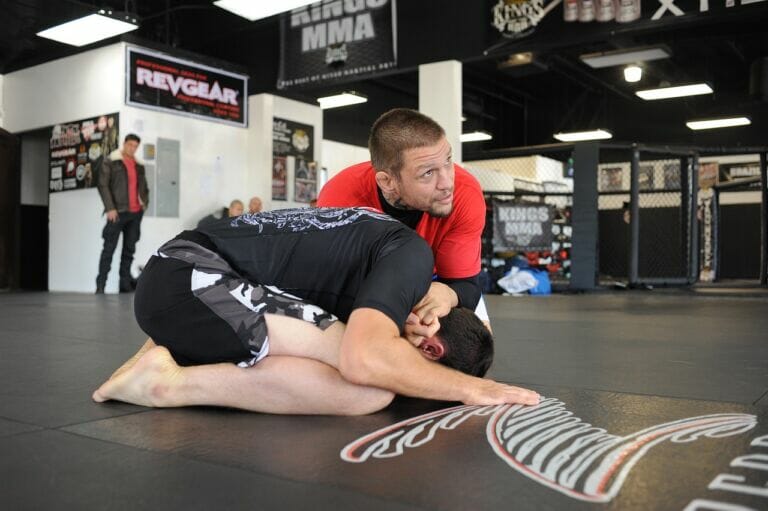The triangle choke: an in-depth guide
The triangle choke, or sankaku-jime in judo, is a popular stranglehold that can be seen in Brazilian jiu-jitsu (BJJ), judo, grappling, and Mixed Martial Arts (MMA) competitions. It is one of the most versatile and efficient submissions. There’s no clear origin of the triangle stranglehold, though it was prevalent in early judo competitions. The front triangle is the most popular version of this move, commonly used in BJJ and MMA.
A 101 guide to one of the most versatile and powerful BJJ submissions.
This guide aims to give you an overview of the triangle, mostly based on concepts from John Danaher’s excellent Triangles: Enter The System instructional. It will cover different variations of the move and give you an overall system in which they coexist. Additionally, we will cover various entries to the position and critical details that make this one of Brazilian jiu-jitsu’s best submissions. At the end of the article, we will discuss the history of the triangle and give you additional resources to study this technique.
What Is the triangle choke?
In Brazilian jiu-jitsu, the triangle choke stands out as one of the most effective and versatile submission holds. It is a strangle that can be used from almost any position, and there are many ways to apply it. There are several main variations of the triangle, such as the front triangle, the opposite side triangle, the rear triangle, the side triangle, and the reverse triangle.
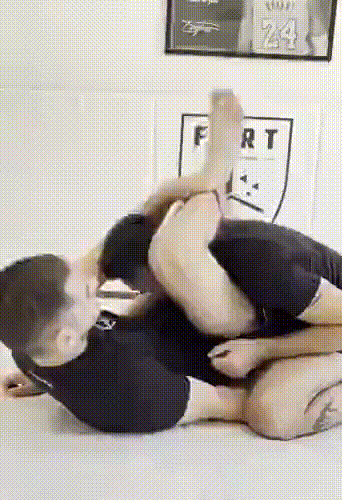
The common element in all triangle attacks is that the attacker’s legs are locked in a triangular, figure-four pattern around the head and one arm of the opponent. This can produce an efficient strangling effect by utilizing the attacker’s legs and the opponent’s shoulder to cut off the blood flow through the carotid arteries. Cutting off the blood flow to the brain, blood chokes cause an opponent to submit or go unconscious.
There are many reasons why someone should become a master of triangles. It is a submission that can be well adapted to both gi and no-gi competitions. Also, it is great for mixed martial arts. Let’s examine some benefits of learning the triangle and why you should emphasize it heavily.
Why you should learn the triangle choke
1. It’s versatile in a range of circumstances
Developing a new skill in Brazilian jiu-jitsu can take a lot of time. Some techniques may need weeks or even months for you to become good at them. Because of this, you should work on techniques that can be used in many situations. It is clear that the triangle is among the most versatile of all the submission holds we use. There are numerous scenarios in which we can use it. It works equally well in grappling and fighting, with or without the gi, and it works well across all weight categories. This versatility is one of its primary appeals.
2. Strangleholds can be better at finishing opponents than joint locks
Developing athletes should consider strangleholds rather than joint locks when mastering a submission. This is because, in some extreme situations, such as a competition, some athletes are prepared to take severe damage to their joints and continue fighting. However, in the case of strangleholds, no amount of courage or mental toughness will save you from going unconscious. Therefore, strangleholds are usually better than joint locks when a choice has to be made between them.
3. Triangles develop leg dexterity and skill
Another reason why you should emphasize triangles is skill development. Triangles require us to develop an extraordinary degree of leg dexterity and coordination, much more so than regular submission holds. These attributes of leg dexterity and coordination can be beneficial in other areas of jiu-jitsu.
Jiu-jitsu is a sport where we should use our legs to wrestle the opponent’s upper body whenever possible. The triangle is an ideal example of this. Every triangle is a fight of our legs and hips against our opponent’s arm, head, and shoulders. By matching the strength of our lower body with the strength of our opponent’s upper body, we can overcome and defeat bigger and stronger opponents. The triangle is one of the best weapons for smaller and weaker athletes to take on and defeat larger adversaries.
How to do a triangle choke
It is best to learn and teach submissions in Brazilian jiu-jitsu by taking a systematic approach. When we look at the triangle, we can see that the best way to do a triangle is to follow a certain 4-step method, split into two stages.
The first stage of a triangle is entering the so-called “trap” triangle. A trap triangle is a lock around our opponent’s shoulder and neck, which looks like a closed guard.
From that form of control, we can move on to the second stage and convert it into a figure-four triangle that can strangle our opponent. If the triangle isn’t enough to finish the job, we must be prepared to switch to other forms of attack.
This two-stage approach is greatly described in John Danaher’s “Triangle: Enter the system” DVD. Let’s examine this two-stage approach and go over the four essential steps of performing a triangle strangle.
Step 1. One in/one out scenario (grips and off-balancing)
The first step in this two-stage system is to create the critical one-in/one-out scenario, which makes all triangles possible. For any triangle to work, we must trap one of our opponent’s arms and head with our legs. All triangles have this in common. We create these scenarios utilizing proper grips and off-balancing (kuzushi).
When grappling or fighting against a resisting opponent, we should always seek to get some kind of dominant grip. There are various forms of grips we can use. For example, we can use the 2-on-1 or the collar & sleeve grip if we are fighting in a gi. They are great tools to off-balance our opponent. The essential off-balance criteria we want to have when looking for a triangle is for our opponent to post his hand on the mat. This is an ideal scenario from where we can hunt triangles.

Step 2. Shooting a trap triangle
Once our opponent is out of balance, we can move on to the second step in the first stage, which is shooting for a trap triangle. A trap triangle is an initial lock on our opponent that looks like a closed guard around our opponent’s one arm and head. Strangling is not the goal here; it is all about controlling and breaking our opponent’s posture. There are two main methods to achieve a trap triangle:
- Foot penetration methods are used when there is a larger distance between our opponent and us. An example of this can be shooting a triangle from open guard.
- Knee penetration methods are used when there is a short distance between our opponent and us. Triangles from closed guard usually use knee penetration methods.
We must be adept at entering trap triangles through both methods to become masters of triangles.
Step 3. Converting to a figure-four triangle
Step number three of this system is to manage the adjustment from a trap triangle to the complete figure-four triangle. This represents the second stage of triangle application, the so-called strangulation phase. To achieve this transition, we need to create a proper angle and work on eliminating the shoulder of our opponent. Many times the system will get completed at this stage. However, there will be many times when we cannot finish the strangulation phase. If this happens, we must proceed to the fourth step.
Step 4. Switching to joint locks
If the triangle turns out to be inadequate, for whatever reason, then we switch to joint locks. We have two choices here; we can go after our opponent’s arms, where the most popular choices are straight arm lock (juji-gatame) and kimura attacks.
In addition, we can attack the lower body, especially if our opponent decides to stand up, which is a common defense. In these situations, we quickly transition to various forms of ashi-garami (leg entanglement) and attack with strong leg attacks.
Variations of the triangle choke
The triangle system is based around John Danaher’s five different forms of the triangle. When most people mention triangles, they usually only refer to one triangle – the front triangle. However, we should never forget that there are five variations that we can use in ground fighting, and they are split into two categories:
Category A
- Front triangle
- Opposite side triangle
- Rear triangle
Category B
- Side triangle
- Reverse triangle
Within each of these categories, whenever you have one form of triangle, you can easily switch to the other as a follow-up attack. For example, if you have a front triangle, you can quickly switch to the opposite side triangle by changing the lock of your legs.
Category A
Front triangle (omote sankaku)

This is the most popular form of the triangle, and most people are familiar with it. It can be used from the top and bottom positions and is the most important in the system.

There are many ways to get into the front triangle. Some entries can be done from the guard position, such as closed guard entries. However, front triangles can be easily set up from the top position, for instance, from mount or side control. When developing strong triangle attacks, the front triangle should be the primary focus of your training. Here is a great video of John Danaher explaining how to do a perfect front triangle:
Opposite side triangle (hantai sankaku)

The second triangle variation is the opposite side triangle, a move that has been underused in Brazilian jiu-jitsu. The opposite side triangle was made popular by Gordon Ryan in his match against Ralek Gracie. Gordon used this variation to finish the fight and counter Ralek’s defensive reactions. You can see the match below:
The opposite side triangle can be used when the opponent defends the front triangle by overhooking your leg, thus preventing you from moving to a perpendicular angle. In this situation, transitioning to the opposite side is a great way to strangle your opponent. You should underhook the leg, invert, and lock your legs below your opponent’s trapped shoulder. This will make a tight choke, even when your opponent defends appropriately.
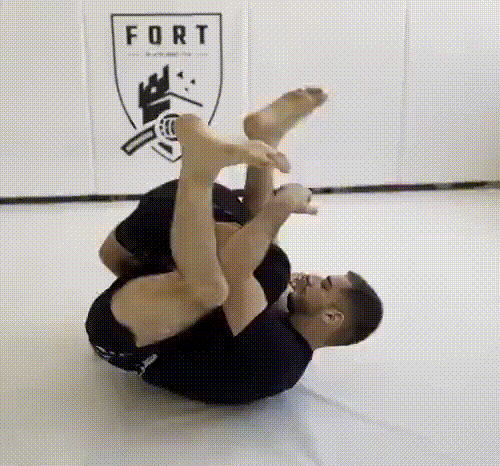
Rear triangle (ushiro sankaku)
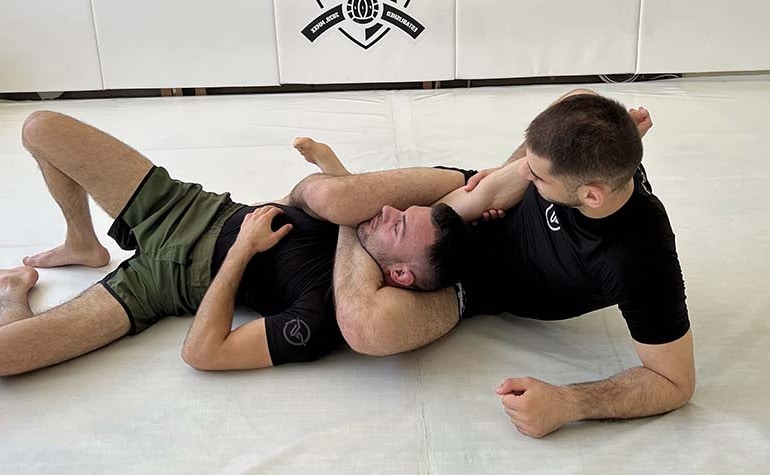
The third triangle in category A is the rear triangle. This variation has become very popular recently and is mainly used from the back position. It complements the straitjacket back attack system and has a lot of value in modern jiu-jitsu.
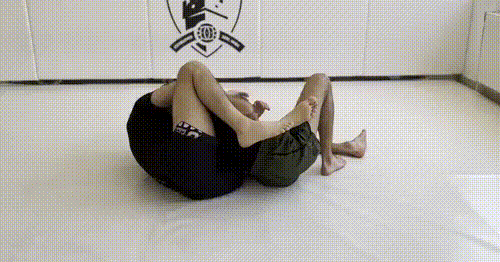
When attacking with this form of the triangle, the critical element is to have your opponent’s arm extended over his head and his elbow on your chest. In addition, this is a great position to attack your opponent’s extended arm as there are arm lock, Kimura, and Americana attacks. Take a look at the video where John Danaher shows some entries to the rear triangle:
Category B
Side triangle (yoko sankaku)

The side triangle is the first triangle in category B. The move is often used in judo, but has recently gained popularity in Brazilian jiu jitsu and grappling. The side triangle is usually performed from the top position or when attacking the turtle.

The best way to use the side triangle is to combine it with a kimura attack from the top. When these two attacks combine, it creates a dilemma for our opponent and often results in a submission. Here is a video of an entry to a side triangle from the top:
Reverse triangle (gyaku sankaku)

The last triangle in this system is the reverse triangle. It is a move that can be used both from the top and bottom, and is often used when an opponent tries to escape from the side triangle. It became famous through Braulio Estima, who used it to finish Andre Galvao in their ADCC finals match.
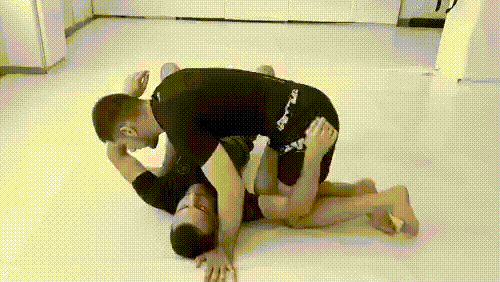
What’s the difference between a regular triangle and an arm triangle?
The main difference between arm triangles and regular triangles is that arm triangles use the strength of our arms instead of our legs. Arm triangles involve techniques such as the kata gatame, anaconda, and D’arce. Since arm triangles don’t fall within the overall triangle system discussed in this article, they cannot be considered regular “triangles” and need to be looked at in depth separately.
How to make your triangle tight
A strong and tight triangle choke is a weapon everyone should have in their jiu jitsu arsenal. It is an attack that can lead you to victory if done right. A tight triangle requires us to solve some central problems during the application. Let’s go through some tips to make your triangle tighter and get you more taps.
1. Create an advantageous angle and eliminate the shoulder
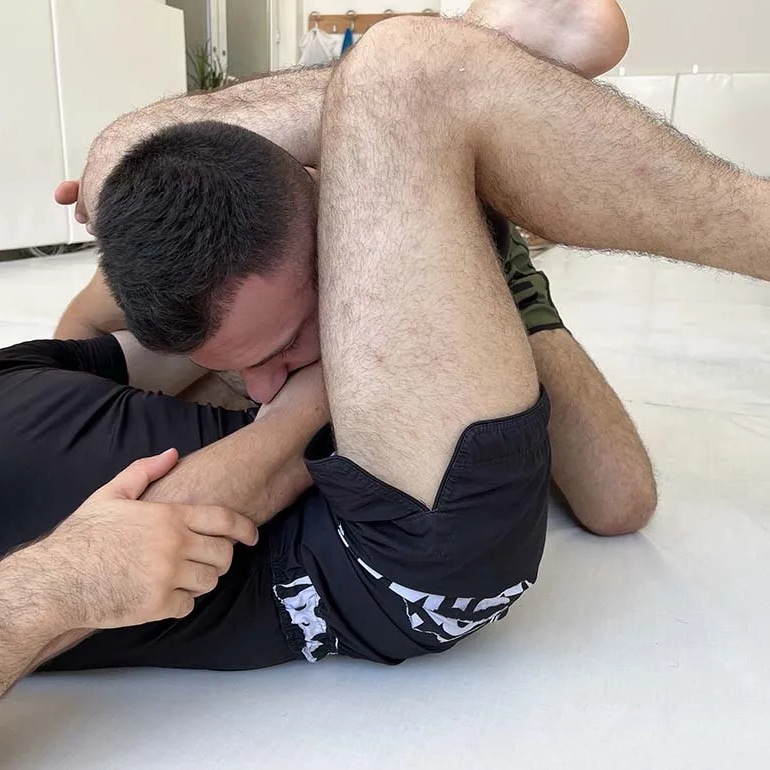
The biggest problem you can run into when going for a triangle is the circumference of your opponent’s neck and shoulder. Locking a complete figure-four triangle on an opponent with broad shoulders can be difficult unless you’re gifted with long, lanky legs.
To have a tight triangle, it’s essential to create a proper angle and remove your opponent’s shoulder from the lock. Plant your free foot on your opponent’s hip, grab your shin, and then pivot so that you are perpendicular to him. You should look directly into your opponent’s ear.

When you have a proper angle, you should eliminate the shoulder. Place your knee on the shoulder inside the triangle and push yourself until the shoulder is no longer inside the triangle. To achieve this, your feet should be pointing in the same direction, perpendicular to your opponent. From this position, lock a figure-four triangle, grab your opponent’s head and squeeze for the finish.
Here’s a video from Lachlan Giles explaining how to eliminate a larger opponent’s shoulder from the triangle:
2. Break your opponent’s posture
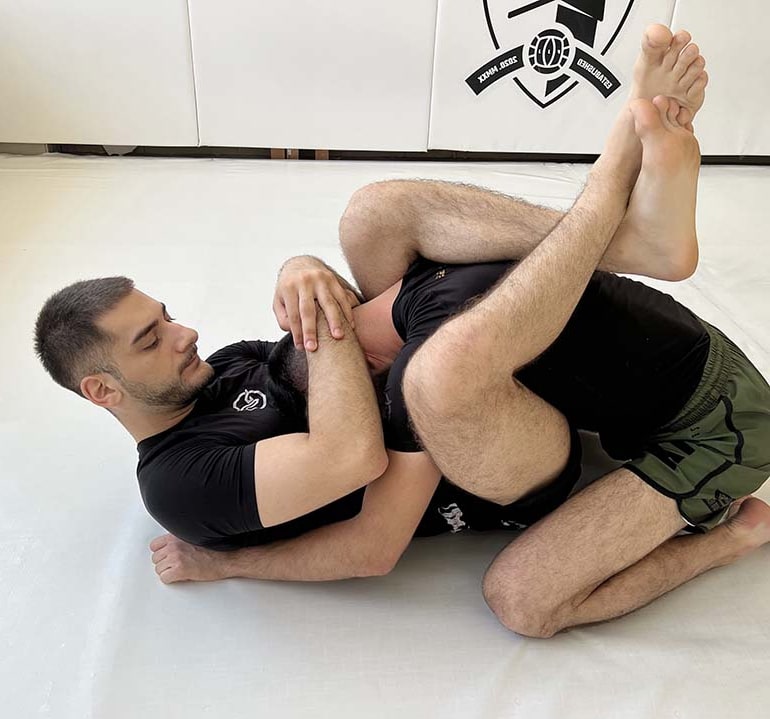
When you lock a triangle over your opponent’s head and shoulder, it is rarely a complete triangle. Initially, you close a trap triangle, which is like a closed guard over your opponent’s arm and neck. After that, you transition to the figure-four triangle and finish the strangle. These are the two stages every triangle has. A skilled opponent can try to posture up during this transition and escape. To avoid this, you must control your opponent’s posture the whole time. There are several ways to do this:
- Knee pull. When you lock a trap triangle, pull your knees toward your chest. Doing so will cause your opponent’s head to move forward and break his posture.
- Shin pull. Another way to break posture is to grab your shin. Make sure to hold the shin of the leg over your opponent’s neck with your opposite arm. Be careful not to catch your foot, as this can be a weak grip.
- Head pull. If you see your opponent trying to get up and create a proper posture, the easiest way to prevent him is to grab his head. Grab the crown of your opponent’s head with both hands and pull him down.
In this demonstration from Rener Gracie, he explains that breaking your opponent’s posture to prepare for the triangle should happen early as soon as you sense they’re getting ready:
3. Underhook the leg
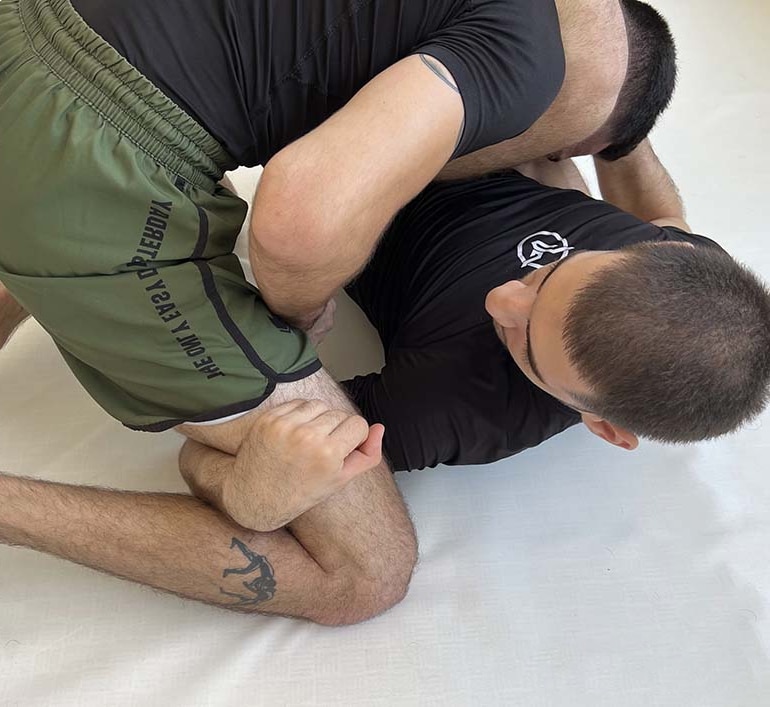
Underhooking the leg opposite the arm inside the triangle will help you create a proper angle and finish the strangle. Additionally, if you are fighting in an MMA fight or in a ruleset where slams are legal, this will prevent your opponent from slamming you and standing up. A great example of this can be seen in Khabib Nurmagomedov’s triangle victory over Justin Gaethje:
How to enter the triangle
In our earlier discussion, we mentioned the triangle’s versatility as one of its best features. As a result of its versatility, the triangle can be accessed from numerous positions. The story of every triangle is the same; it’s all about getting to that one in/one out scenario and then working towards the strangle!
Some of the best entries to the triangle come from the guard position, but we can also use entries from the top. Additionally, the triangle is a great way to counter single legs when our opponent tries to take us down.
Triangle entries from guard
The guard position is excellent for getting to the triangle. Whether you are using a gi or not, you can use many guard forms. The best guard positions to get to the triangle are the closed guard and the open guard. The closed guard gives you the necessary control of your opponent’s posture. Additionally, you can use many strong grips from the closed guard, such as the belt grip, collar grip, underhook, overhook, etc.
Alternatively, open guards such as the spider guard and the de la riva guard make your legs very mobile, so a trap triangle is easy to set up.
Triangle entries from the top position
Dominant positions such as the mount, side control, and back control are excellent opportunities to hunt for triangles. From these positions, you can enter various forms of triangles, such as the front triangle, rear triangle, and side triangle.
Triangle vs single leg takedown
One of the best ways to use the triangle is as a reversal, especially when our opponent goes for single leg takedowns. Single legs are a scenario where our opponent creates the much-needed one in/one out scenario for us. From there, we can reverse with front triangles, opposite side triangles, or side triangles.
How to defend a triangle choke
Attacking with triangles is a great skill, but you should know how to defend yourself if caught in one. First, you should not allow your opponent to get a perpendicular angle and eliminate your shoulder. This is best done by gluing your trapped elbow to the floor. From there, you can look to stand up and put pressure on your opponent, so he has to let go of the triangle. Here is a great escape from Andre Galvao you can watch:
History of the triangle choke
Numerous Brazilian jiu-jitsu and grappling moves have been around for a long time. There are ancient drawings of some techniques being performed thousands of years ago in ancient Pankration.
However, the triangle is a relatively new technique, first used in Kosen judo at the start of the 20th century. In the book Choque: The Untold Story of Jiu-Jitsu in Brazil 1856-1949 by Roberto Pedreira, he claims the triangle was a judo technique actually inspired by two high school judokas in Japan.There is no evidence of the triangle being performed before that. The first version of the triangle choke created was the front triangle, and the side triangle was invented afterward. Many also believe that Masahiko Kimura developed this technique during a judo tournament. However, it is more probable that he just popularized it.
When Royce Gracie started fighting in the Ultimate Fighting Championship, he introduced the general audience to many techniques of Brazilian jiu-jitsu. One of his most memorable finishes was in his fight against Dan Severn, where he used the triangle to finish Severn, who was much larger than Royce at the time.
Another memorable use of the triangle was by Anderson Silva in his fight against Chael Sonnen. Silva was losing the fight by a long margin, but he managed to lock a front triangle at the end and win the fight.
The triangle was probably introduced to Brazilian jiu-jitsu by Rolls Gracie. According to a popular belief maintained by Romero Cavalcanti, Rolls may have introduced the technique after finding it in a judo book. Márcio “Macarrão” Stambowsky, who Rickson Gracie named as one of the earliest Brazilian competitors to popularize the technique, has also credited Rolls.
Triangle specialists
Here are some jiu jitsu athletes famous for their use of the triangle choke:
Learn more about the triangle
If you want to learn more about the triangle, I have included some additional resources below. Enjoy!

